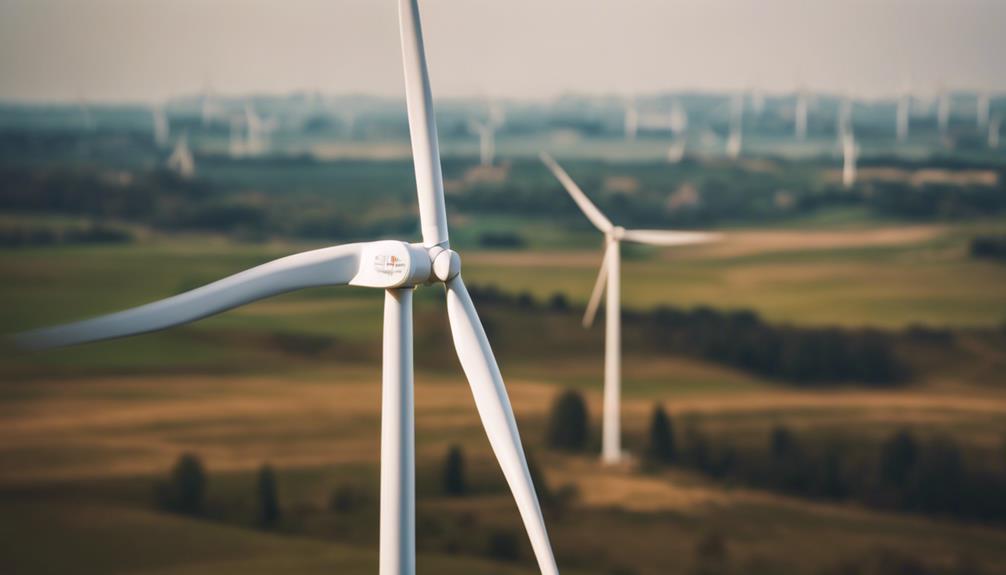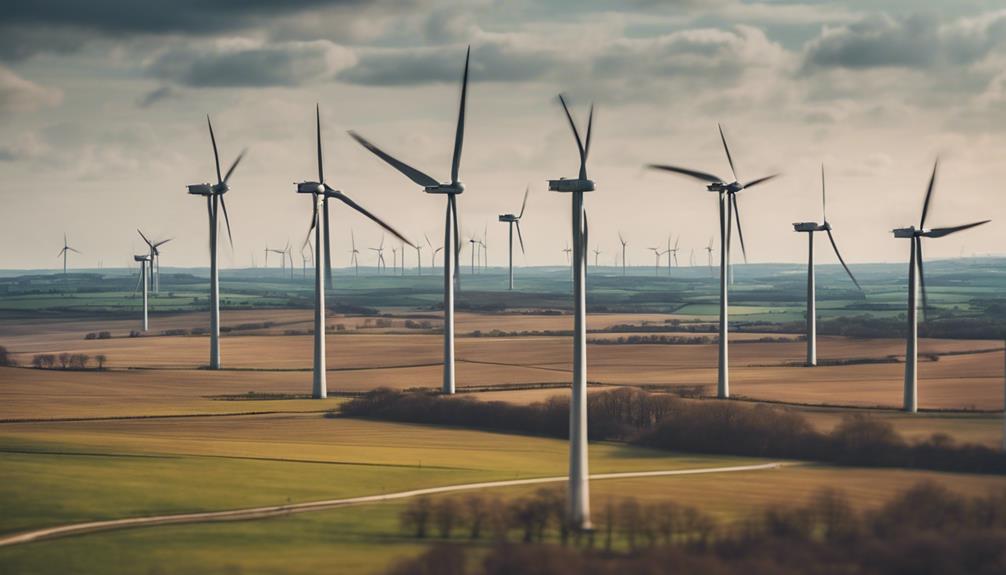To make a wind turbine work efficiently, you need a steady wind blowing at 10 to 20 mph. This speed range jump-starts the turbine into converting wind energy to electricity effectively. The turbine's power output is at its best when the wind speed stays within this essential range. So, if you want to learn more about optimizing wind turbine efficiency, keep in mind how vital wind speed is for getting the most out of these green energy generators.
Key Takeaways
- Wind turbines require 6-9 mph to start operating efficiently.
- Optimal wind speeds for maximum power output are 10-20 mph.
- Wind speed affects turbine efficiency directly.
- Anemometers measure real-time wind speed for turbine performance.
- Turbine design and maintenance impact energy generation efficiency.
Wind Speed Requirements
To efficiently produce electricity, wind turbines require wind speeds ranging from 6 to 9 mph initially. These wind speeds are necessary for kickstarting the turbines into action and allowing them to start generating power effectively. Without reaching this threshold, the turbines may struggle to produce electricity efficiently.
Once the turbines have started generating power, they operate best in wind speeds between 10 to 20 mph for peak performance. It's vital to make sure that the wind speed remains within this range to maximize the turbine's output.
Measuring wind speed accurately is crucial in guaranteeing that the wind turbines operate within their design limits. Anemometers are commonly used for this purpose, providing real-time data on wind speed to help maintain the turbine's efficiency.
Remember that wind power generation is heavily influenced by wind speed, with the power output being proportional to the cube of the wind velocity. Hence, adequate wind speeds are necessary to harness the full potential of wind energy and generate electricity effectively.
Optimal Wind Conditions
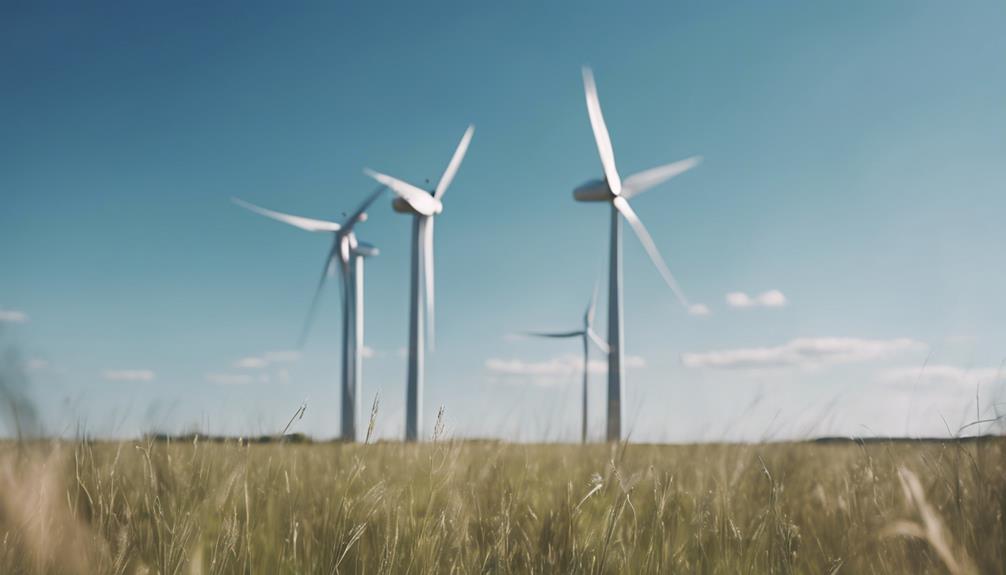
Wind turbines operate most effectively when subjected to specific wind speeds, ensuring peak energy production and performance. To achieve the best turbine performance, it's essential to have the ideal wind conditions, including:
- Wind Speed: The ideal wind speed range for efficient electricity generation typically falls between 10 to 20 miles per hour.
- Wind Power: Wind speed plays a crucial role in maximizing wind power output, as it's directly proportional to the cube of the wind velocity.
- Efficient Electricity Generation: Turbines are designed to capture and convert wind energy into mechanical power, which is then transformed into electricity, emphasizing the importance of ideal wind conditions.
Maintaining these ideal wind conditions is necessary for ensuring that wind turbines can operate at their maximum potential, contributing significantly to sustainable energy production. Accurate assessment of wind speed and conditions is key to determining the feasibility and efficiency of wind energy generation.
Wind Turbine Efficiency Factors
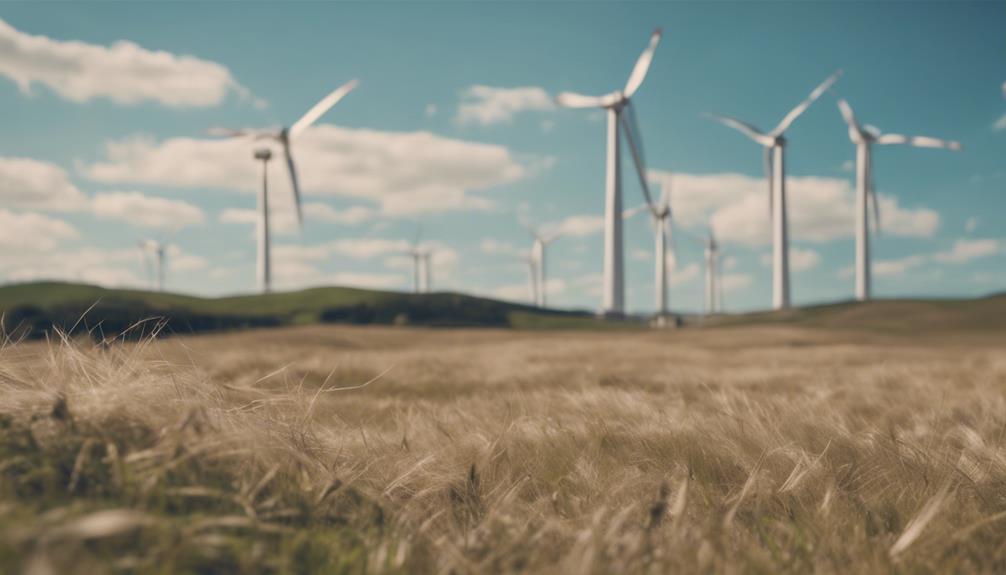
When analyzing efficiency factors for wind turbines, it's important to factor in the impact of wind speed.
The speed of the wind directly affects how much energy a turbine can generate, emphasizing the significance of ideal wind conditions for maximum efficiency.
Understanding how wind speed influences efficiency is essential for harnessing the full potential of wind energy.
Efficiency Factors Analysis
Considering the various factors influencing wind turbine efficiency, an in-depth analysis of efficiency factors is necessary for optimizing electricity generation.
When evaluating the efficiency of a wind turbine, several key factors come into play:
- Turbine Design: The design of the turbine blades and overall structure greatly impacts efficiency by affecting how well the turbine can capture wind energy.
- Maintenance Practices: Proper and timely maintenance is essential for ensuring the turbine operates at peak efficiency, minimizing downtime, and maximizing energy output.
- Wind Speed: Wind speed plays an important role in determining how much energy a wind turbine can generate. Higher wind speeds generally lead to increased efficiency and electricity production.
Wind Speed Impact
To maximize wind turbine efficiency, understanding the impact of wind speed is essential in maximizing electricity generation. Wind speed plays a pivotal role in determining the amount of power a turbine can generate. The relationship between wind speed and electricity generation isn't linear but follows a cubic function; this means that even small increases in wind speed can result in markedly higher power output.
Wind velocity cube law dictates that the power generated is proportional to the cube of the wind speed, underlining the vital importance of wind speed in turbine performance.
Turbine designs are tailored to specific wind speed conditions to ensure peak efficiency. Anemometers are commonly used to measure wind speed accurately, allowing for adjustments to turbine settings based on real-time conditions. Wind resource maps are valuable tools that estimate the wind potential in different locations by analyzing prevailing wind speeds.
Impact of Wind Speed Variability

You should be aware that wind speed plays an essential role in the efficiency of wind turbines.
Variability in wind speed directly impacts the power output of turbines.
Understanding this correlation is vital for optimizing the performance of wind turbines and maximizing electricity generation.
Wind Speed Importance
Wind speed variability greatly influences the electricity generation efficiency of wind turbines due to its direct impact on power output. When it comes to wind speed significance, consider the following:
- Power Output Dependency: The power output of wind turbines is heavily reliant on wind speed, with even minor changes in wind speed leading to significant alterations in energy production.
- Site Suitability Assessment: Wind resource assessments rely on data related to wind speed variability to determine the feasibility and ideal siting of wind turbines for maximal energy generation.
- Design Adaptations: Various wind turbine designs are tailored to suit specific wind speed conditions in different locations, ensuring that turbines operate optimally and achieve maximum energy generation efficiency.
Anemometers play a crucial role in accurately measuring wind speed, providing essential information for evaluating the potential energy output of wind turbines in various settings. By understanding the importance of wind speed, you can appreciate its vital role in determining the effectiveness and productivity of wind energy generation.
Turbine Efficiency Correlation
The efficiency of wind turbines is closely connected to the variability of wind speeds, directly impacting their performance and energy generation capabilities. Turbine efficiency depends on the consistency and strength of wind speeds, with higher and more uniform winds leading to increased electricity production. Wind speed variability plays an essential role in determining the best functioning of wind turbines.
Anemometers are crucial instruments used to measure these fluctuations, providing data that influences the efficiency of turbine operations. Turbines require a specific range of wind speeds to operate at peak efficiency, with both too low and too high speeds affecting their output. By understanding the correlation between wind speed variability and turbine efficiency, operators can optimize the performance of wind turbines to maximize energy generation.
Consistent and strong winds are key factors in ensuring that wind turbines operate efficiently and contribute significantly to sustainable energy production.
Power Output Variation
Measuring wind speed variation plays a vital role in determining the power output of wind turbines. The variability in wind speed directly impacts the efficiency and effectiveness of the turbines, influencing the amount of electricity they can generate.
To better understand this concept, consider the following:
- Wind Speed Impact: Changes in wind speed greatly affect the power output of wind turbines, with even slight variations leading to noticeable differences in energy production.
- Best Performance Ranges: Wind turbines operate most effectively within specific wind speed ranges, where they can harness the maximum amount of energy from the wind.
- Anemometer Importance: Anemometers are essential tools used to measure wind speed accurately, providing important data for optimizing turbine performance and adjusting their settings for efficient operation.
Wind Turbine Power Generation
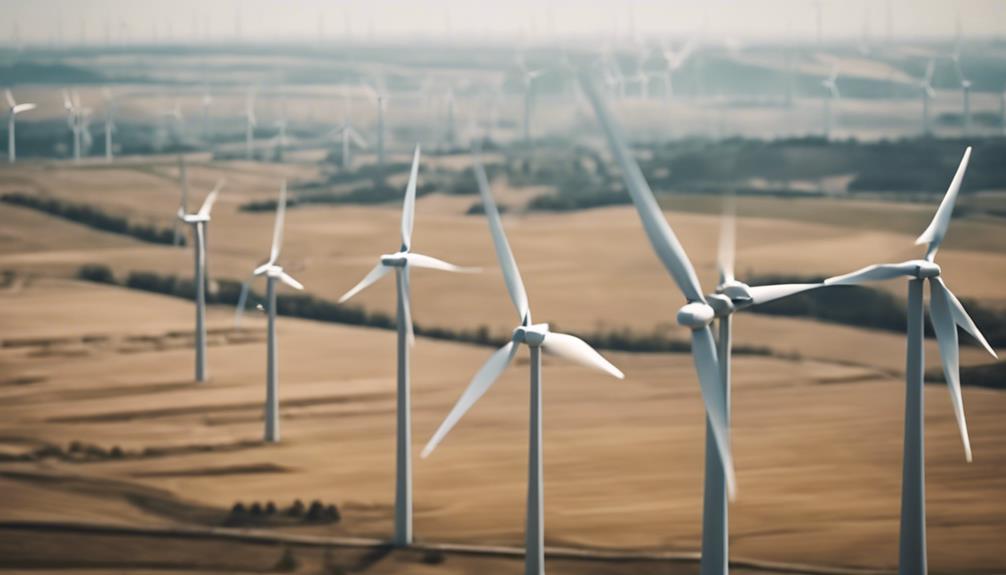
To optimize the efficiency of wind turbine power generation, anemometers measure wind speed and direction. Wind turbines kick into action at speeds between 6-9 miles per hour, with power output increasing as wind speed rises due to the cubic relationship between wind power and velocity.
This underscores the importance of wind speed in maximizing electricity production. Tailoring rotor blade designs according to varying wind speeds is pivotal for enhancing power generation efficiency and ensuring economic viability. By utilizing different blade designs, turbines can adapt to fluctuating wind conditions, extracting the maximum potential electricity output from the available wind resource.
Understanding and harnessing the relationship between wind speed and turbine power is crucial for optimizing energy production and ensuring the sustainable generation of electricity from wind resources.
Sustainable Wind Energy Production
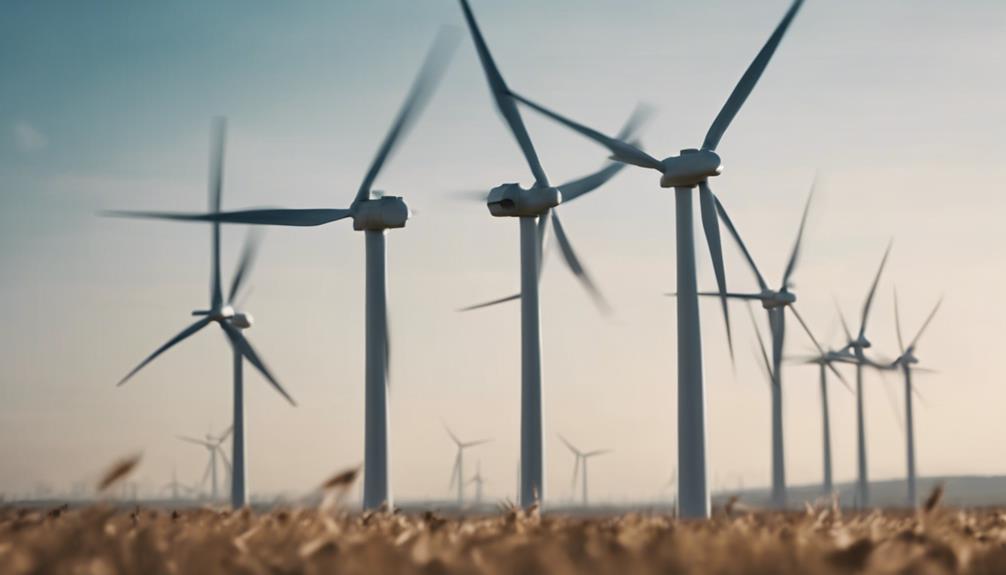
Wind energy sustainability relies heavily on harnessing ideal wind speeds for efficient electricity generation. To ensure sustainable wind energy production, it's important to take into account the following:
- Renewable Energy: Wind energy is a key player in the field of renewable energy, offering a clean and sustainable alternative to traditional fossil fuels.
- Wind Turbines: These structures are crucial in converting wind energy into electricity, with their effectiveness directly linked to the prevailing wind speeds.
- Energy Output: The amount of electricity generated by wind turbines is greatly influenced by wind speeds, with higher velocities significantly enhancing energy output.
Understanding the dynamics of wind speeds and their impact on wind turbine efficiency is essential for maximizing sustainable energy production. By optimizing wind turbine placement in areas with consistent and adequate wind speeds, the potential for harnessing renewable wind energy to meet electricity demands can be greatly improved.
Frequently Asked Questions
How Much Wind Does It Take to Start a Wind Turbine?
To start a wind turbine, you need wind speeds of 6 to 9 miles per hour. The blades must reach a specific rotational speed to generate power effectively. Anemometers accurately measure wind speed for best performance.
How Much Wind Does a Wind Turbine Need to Move?
You need wind speeds between 10 to 20 miles per hour for best performance. Lower speeds may not generate enough electricity efficiently. Remember, too much wind, exceeding around 55 miles per hour, can pose safety risks!
How Big of a Wind Turbine Do You Need to Power a House?
To power a house, you'll need a wind turbine ranging from 5kW to 15kW. These turbines, mounted on tall towers, generate about 10,000 kWh yearly. They typically require wind speeds of 9-10 mph for efficient electricity production.
How Windy Is Too Windy for Wind Turbines?
When it gets too breezy for wind turbines, they face potential damage, leading to shutdowns for safety. Operating within the best wind speed range guarantees efficiency and longevity. Control systems adjust blade angles to maximize energy production.
Conclusion
So, now you know how much wind is needed for a wind turbine to be effective.
Remember, when it comes to harnessing wind power, the early bird catches the worm.
By understanding the wind speed requirements and optimizing conditions, you can maximize the efficiency of your wind turbine.
Keep on chasing the wind, and you'll be well on your way to sustainable energy production.
